
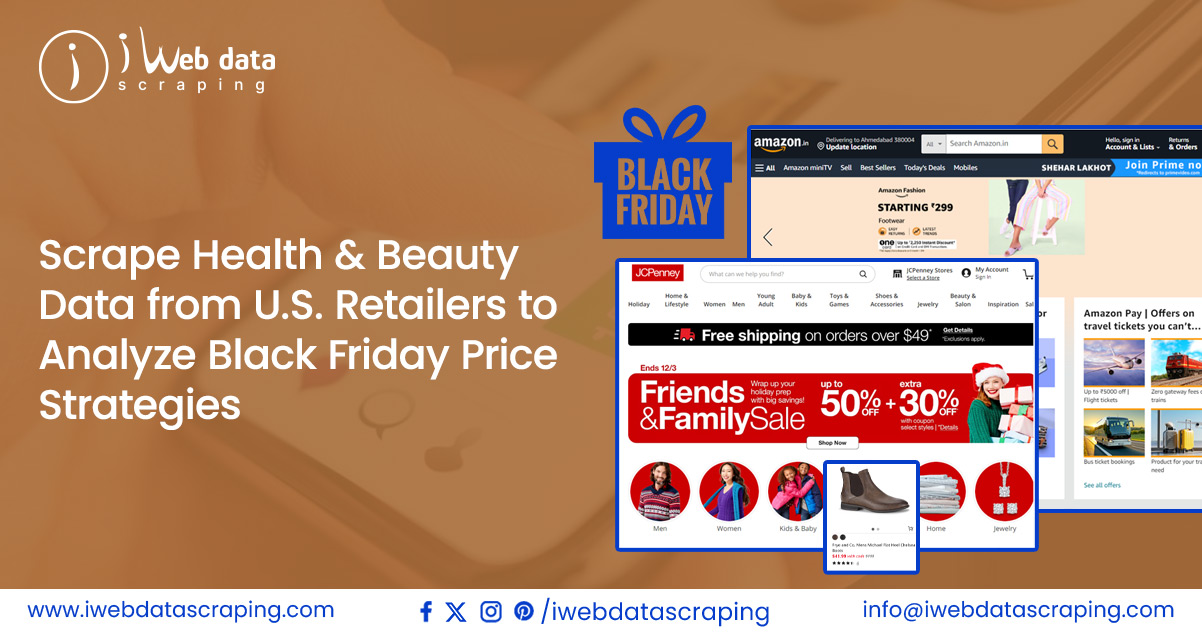
From the humble origins of face paint and medicinal herbs, the health and beauty industry has evolved into a multi-billion-dollar juggernaut. Today, consumers face an overwhelming array of choices promising something for everyone. Scrape health and beauty data from US retailers to find a recent study on the prominence of Health and beauty as one of the most popular Consumer Packaged Goods (CPG) categories in the U.S., boasting substantial assortment diversity and brand concentration on Black Friday. Unsurprisingly, pricing activity in the Health and beauty sector is particularly dynamic during the Thanksgiving weekend.
As part of our ongoing series delving into the pricing strategies of leading retailers across various categories on Black Friday, the iWeb Data Scraping team conducted a comprehensive analysis by scraping retail data. It examined a sample comprising over 14,000 products from six major retailers: Amazon, JC Penney, Macy's, Nordstrom, Target, and Walmart. The analysis focused on seven product types within the Health and beauty category, including Fragrance, Hair Care, Makeup, and more. The focal point was to scrape Black Friday Price data and determine the top 500 ranked products in each product type, providing a detailed exploration of the pricing dynamics surrounding these coveted items.
In our analytical approach, we delved into the Black Friday Price Strategies landscape by examining the mode of prices in the week preceding the sale and contrasting it with the pricing during the sale period. This method illuminated the nuanced realm of additional markdowns implemented throughout the sale, providing a detailed insight into the pricing strategies adopted by retailers.
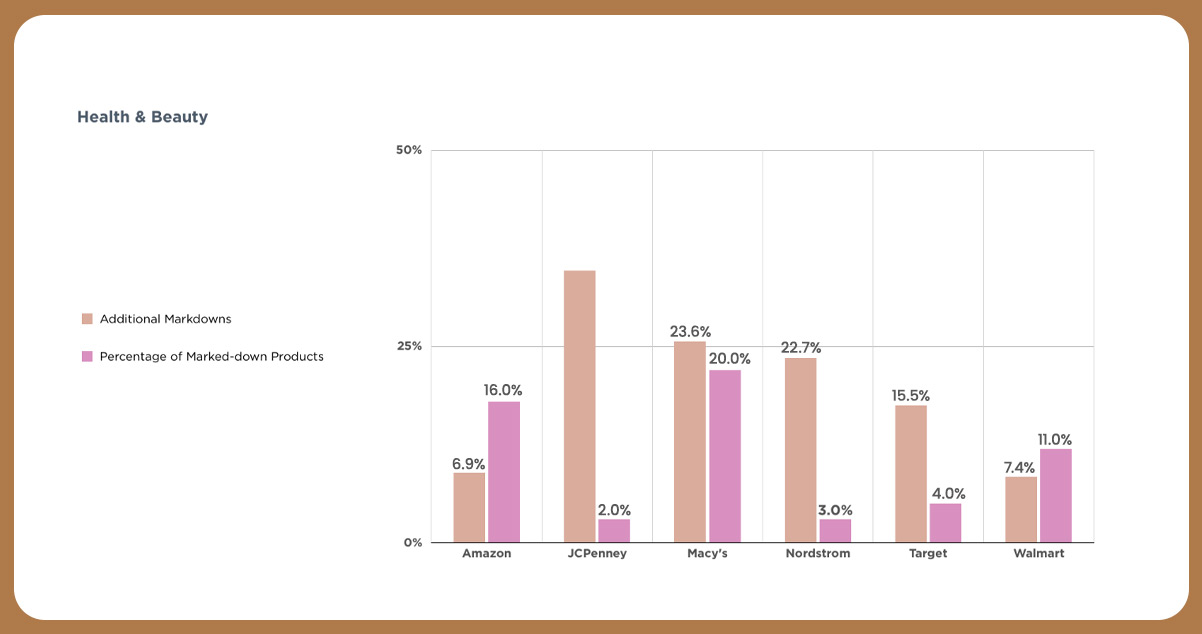
Similar to our previous examination of the Fashion category during Black Friday, our retail data scraping services found that Macy's emerged as the leader with the most extensive coverage of marked-down products, encompassing 23.6% of its offerings. The average percentage of markdowns across retailers stood at 20%, with JC Penney surpassing this average with an impressive 33.7%. However, it's noteworthy that JCPenney's high average was applicable to a more limited range, covering only 2% of its products.
Conversely, Amazon and Walmart opted for more conservative markdowns, offering the lowest percentages at 6.9% and 7.4%, respectively. Despite these lower percentages, Amazon and Walmart secured positions in the top three for the number of products covered, with 16% and 11%, respectively. Target and Nordstrom fell in the mid-range for markdown percentages, with 4% and 3%, respectively, but showcased a more selective approach, applying these discounts across a more limited selection of products.
As we navigated more into the analysis, it became evident that the retailers had distinct markdown strategies tailored to specific product types. Notably, there was a prevalent trend among most retailers to apply substantial discounts to makeup, shampoo & conditioner, and men's hair care products. The table below outlines the top three product categories with the highest markdowns for each retailer in our analysis. This nuanced approach sheds light on how retailers strategically targeted specific product types to maximize the impact of their Black Friday promotions.
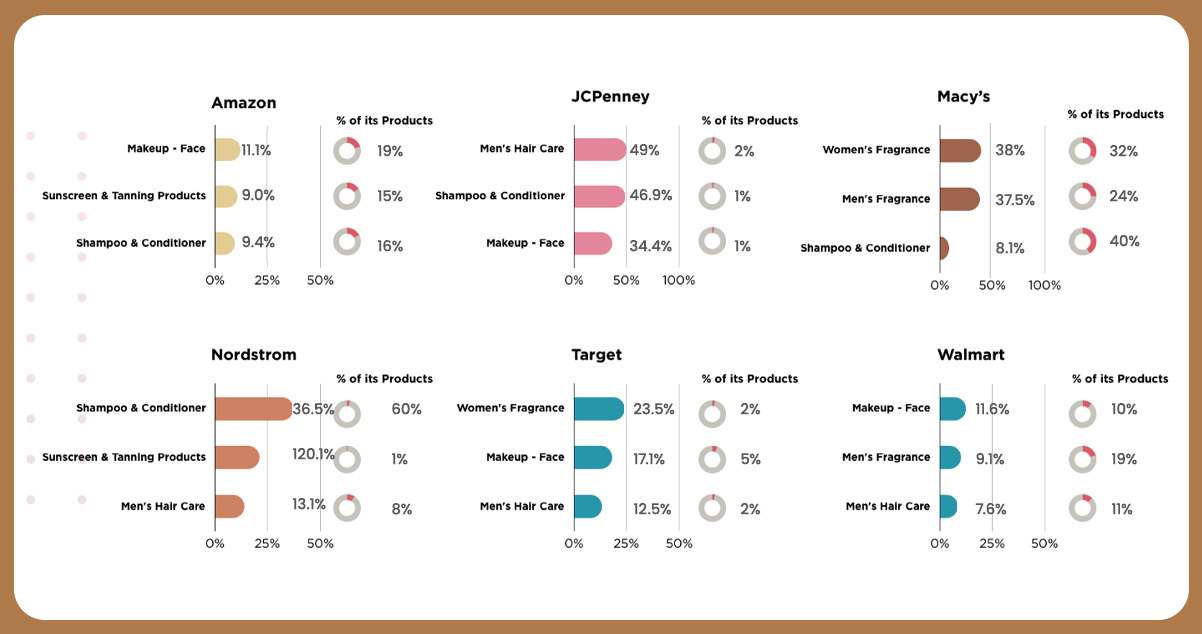
Our analysis classified products among different tiers based on their relative pricing compared to other products within the same retailer and product type. In cases where the Manufacturer's Retail Price (MRP) was not explicitly displayed, we utilized the highest observed price during the holiday period leading up to Black Friday for categorization. Products were then labeled as High, Medium, or Low in terms of their premiumness, with the High category reserved for the more expensive products within the retailer's offerings. This tiering approach provided a nuanced understanding of how retailers positioned and priced products across varying premium levels during Black Friday.

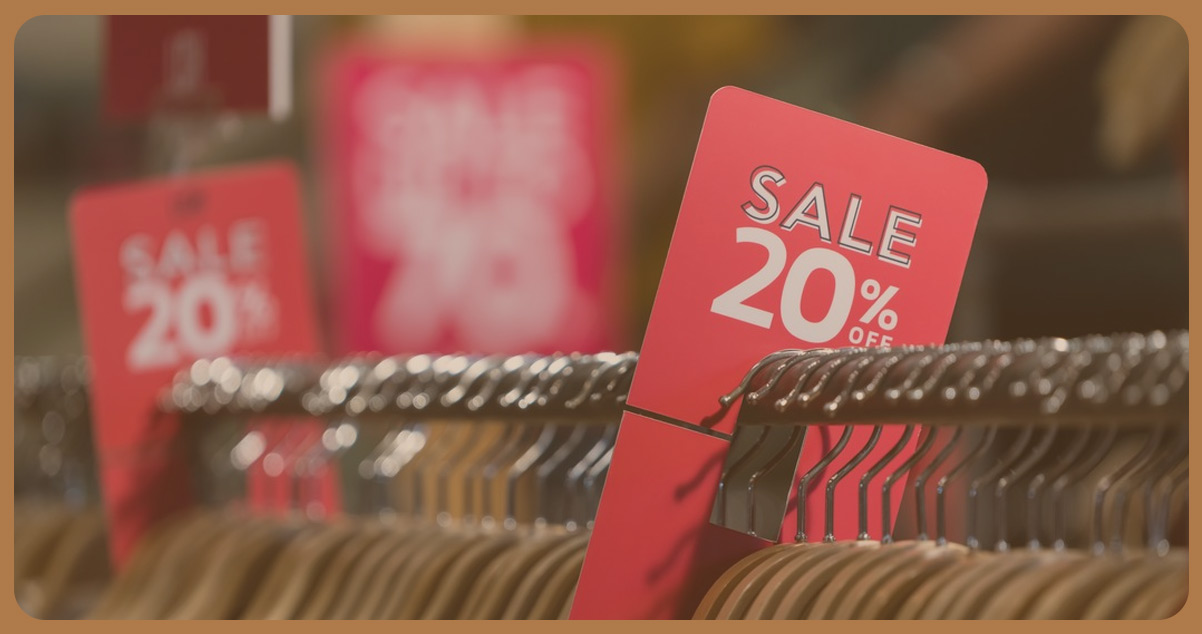
Continuing established patterns, Macy's emerged as a front-runner by implementing the most substantial markdowns on its high-tier products, boasting a notable 33.8% reduction. Macy's also exhibited the broadest coverage within this category, encompassing 20% of its products.
Amazon, Macy's, Target, and Walmart adhered to the expected trend, strategically offering higher markdowns on their premium products and extending these discounts to a more significant proportion of their premium offerings. This strategic approach aligns with their goal of presenting compelling offers on high-end goods while safeguarding their profit margins.
However, JCPenney and Nordstrom deviated from this trend. JC Penney opted for higher markdowns on its lower-priced items, while Nordstrom directed its markdown focus towards products in the medium-tier category. It's crucial to note that the portion of products with markdowns was relatively limited for both JC Penney and Nordstrom. This nuanced analysis reveals how retailers adopt varied strategies regarding pricing and discounting across different product premium levels during the Black Friday period.
In alignment with the methodology employed for categorizing products based on their premiumness, we extended this approach to classify them into distinct levels of popularity. Popularity in this context is gauged through a composite assessment considering the average review rating and the total number of reviews garnered by each product. This tiering strategy provides a nuanced understanding of how products are positioned across different levels of popularity, enriching the analysis of consumer preferences and market trends.
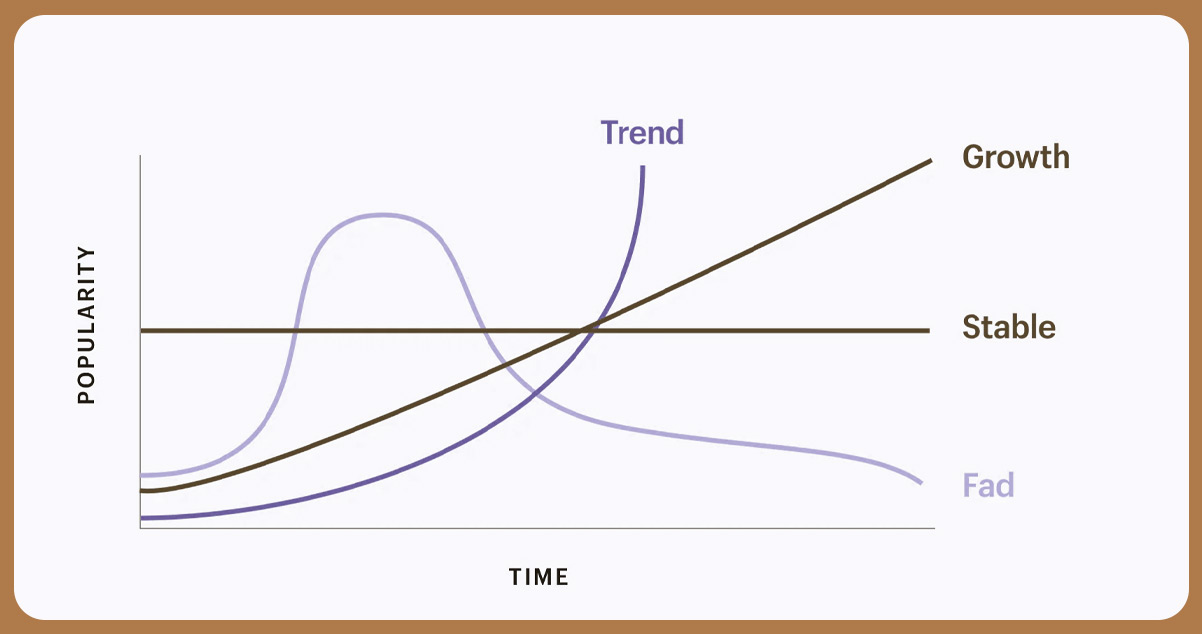

Surprisingly, no consistent pattern emerges among retailers, indicating a strategic correlation between product popularity and Black Friday pricing. Macy’s, JC Penney, and Nordstrom opted for higher markdowns on their trendy products, with JC Penney and Macy’s also discounting a more significant portion of these items. Conversely, it's notable that retailers, including Amazon, frequently reduced prices on their less popular products. It likely reflects a concerted effort to clear excess stock of less popular items during the sale period.
The traditional notion of Black Friday as a single-day event has evolved, with attractive offers extending throughout November, particularly in the last week. Tracking pricing activity across retailers during this period revealed varying price changes. Retailers exhibited diverse strategies, evident in both the frequency of price adjustments and the average price variations, showcasing the dynamic and evolving nature of Black Friday sales.
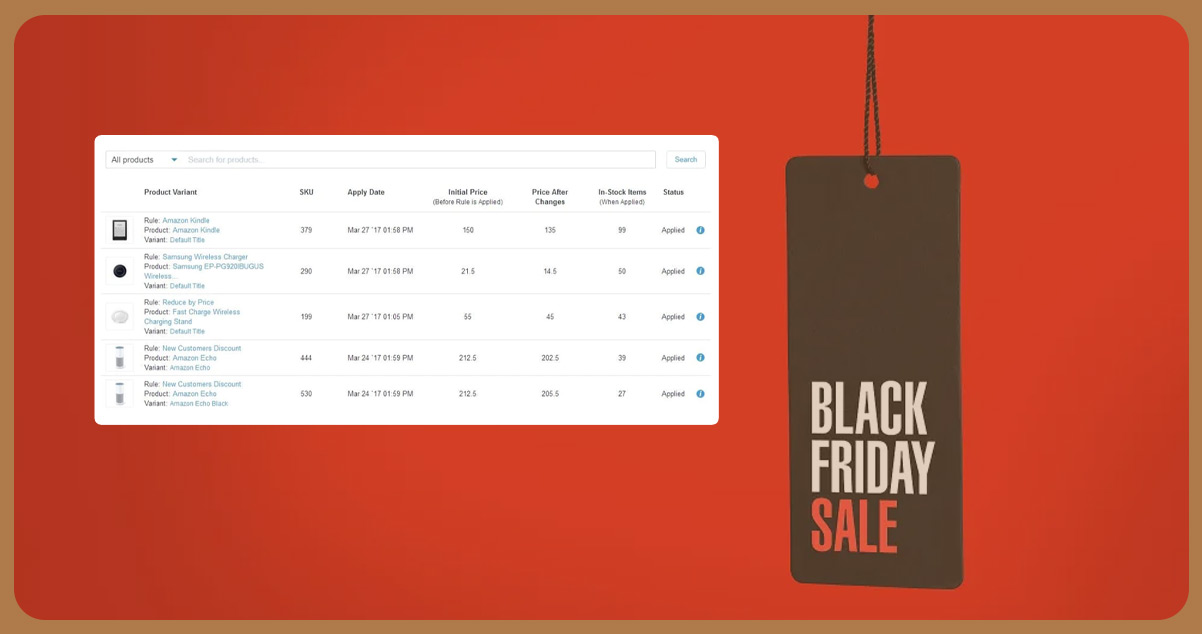
In the usual fashion, Amazon exhibited a substantial lead in the number of pricing changes, reaching a peak at 2500 for the tracked products. Walmart followed, albeit significantly behind, with 616 changes on the 27th. Despite multiple adjustments, Amazon and Walmart maintained a relatively low average price change variation, hovering around 10%.
With Macy’s being a slight exception in the days leading up to Black Friday, other retailers implemented fewer price changes. However, changes nearly halted the day before and only saw a marginal increase on the 29th.
While most retailers adhered to a pattern of decreasing price variation on the 28th and a significant increase the following day, Nordstrom and Walmart defied this trend. These outliers seemingly opted to provide early discounts on Black Friday.
Conclusion: In summary, Macy’s stood out with comparatively higher markdowns across a broader range of products. JC Penney, Nordstrom, and Target offered seemingly high markdowns on a limited selection of items. As expected, Amazon and Walmart maintained their conservative approach to additional markdowns during the sale while ensuring extensive product coverage.
Feel free to get in touch with iWeb Data Scraping for comprehensive information! Whether you seek web scraping service or mobile app data scraping, our team can assist you. Contact us today to explore your requirements and discover how our data scraping solutions can provide you with efficiency and reliability tailored to your unique needs.